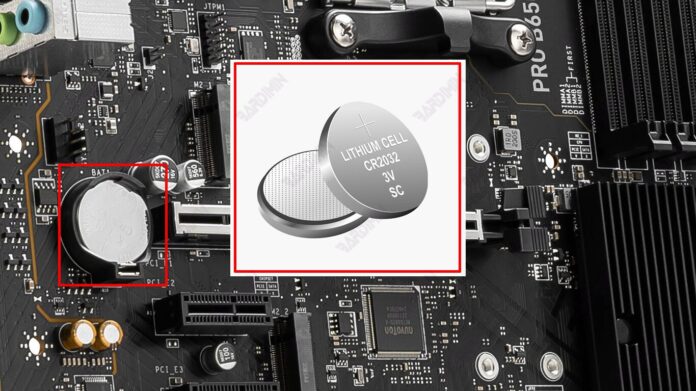If you’ve ever opened a computer case, you may see a small, round-shaped battery that resembles a watch battery. These batteries are located in the motherboard and are called CMOS batteries.
The motherboard is the main component in a computer that serves as a link between various hardware. The motherboard organizes the communication between the CPU (Central Processing Unit), RAM (Random Access Memory), GPU (Graphics Processing Unit), and other hardware.

Coin batteries, often known as CR2032, are small, round, coin-shaped batteries located on the motherboard. Despite its small size, these batteries have a very vital role in keeping some basic computer functions running properly. In this article, we will explore why these coin batteries exist in motherboards and what they do.
Let’s explore why motherboards need these batteries and how their functions affect your PC’s performance.
What is a Coin Battery on a Motherboard?
Coin batteries, the most commonly used in motherboards, are lithium batteries known by the code CR2032. These batteries have a round and flat shape, similar to a coin, with a diameter of about 20 mm and a thickness of about 3.2 mm. CR2032 is one of the most popular types of batteries due to its large enough capacity for such a small size, as well as its long durability.
Coin batteries are usually installed in a special slot on the motherboard called a battery socket. This socket is designed to hold the battery securely and ensure good contact with the connector pins on the motherboard. Coin batteries are often located near the chipset or in an area that does not interfere with other components, making them easy to reach when they need to be replaced.
Main Functions of Coin Batteries on Motherboards
Maintaining Time and Date
One of the main functions of a coin battery on a motherboard is to keep the time and date settings on the computer. When the computer is turned off and not connected to a power source, this coin battery provides the power necessary to keep the internal clock and calendar running.
This is important because many applications and operating systems rely on accurate times and dates to function properly. If the time and date don’t match, you may face a variety of issues, from difficulty accessing websites to problems with file syncing.
Example: If you use a computer for business purposes, especially for scheduling, email, and applications that require accurate time, having the right time and date settings is always very important. Without a coin battery, every time your computer is turned off, you will have to manually reset the time and date when you turn it back on.
Saving BIOS/UEFI Settings
In addition to maintaining the time and date settings, coin batteries also have a crucial role in storing BIOS/UEFI settings. The BIOS (Basic Input/Output System) or UEFI (Unified Extensible Firmware Interface) is the firmware that governs the basic functions of your computer’s hardware. The BIOS/UEFI stores various important settings, such as boot order, hardware configuration, overclocking settings, and so on.
When the computer is turned off, the coin battery ensures that all of these settings remain stored and not lost. Without a coin battery, every time the computer is turned on, the BIOS/UEFI settings will revert to the factory default settings, which can cause various operational problems. For example, the boot order may change, and the computer may not be able to find the operating system correctly.
Example: If you have set the BIOS to boot from an SSD and not from an HDD, losing this setting will cause the computer to try to boot from the HDD by default, which may not have an operating system installed. This will cause the computer to fail to boot until you reset the BIOS.

